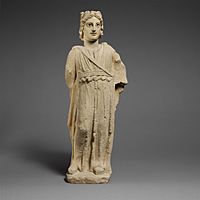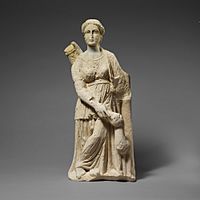Telesilla facts for kids
Telesilla (pronounced Teh-leh-SEE-lah) was an ancient Greek lyric poet. She lived in the city of Argos around 2,500 years ago, in the 400s BC. Telesilla is famous for a story where she supposedly helped defend her city. While this story is probably not entirely true, it shows how important she was.
Only a few pieces of her poems still exist today. Many of these mention the Greek gods Apollo and Artemis. She was well-known in her time and even had a special poetry style, called the Telesillan metre, named after her.
Her Life and the Story of Argos
We don't know much for sure about Telesilla's life. She came from the city of Argos, which is in Greece.
There's a famous story about Telesilla. It says that in 494 BC, the city of Argos was attacked by King Cleomenes I of Sparta. The Spartan army had defeated the men of Argos.
According to the story, Telesilla bravely gathered the older men, women, and even slaves of the city. She organized them to defend Argos. They fought so well that the Spartans eventually left. Some ancient writers said that a festival called Hybristica celebrated this victory.
However, many modern experts don't think this story is completely true. A famous historian named Herodotus wrote about the battle but didn't mention Telesilla or the women defending the city. It's thought that the story might have been made up later. It could have been created to explain an ancient prophecy that said women would drive out men. Even if the story isn't fully true, it shows that Telesilla was a very respected person in Argos.
Her Poetry
Only nine small pieces of Telesilla's poems have survived. Most are just a word or two long. What we have suggests she wrote about local stories and legends from Argos.
Ancient writers like Pausanias and Plutarch said that women especially admired her work. Her poems seem to have focused on the lives of women. Several fragments mention the gods Artemis and Apollo. One piece might be from a poem about the wedding of the gods Zeus and Hera.
Telesilla's poetry was so special that a type of rhythm, or "meter," in poetry was named after her. It's called the Telesillan meter. The longest piece of her poetry that we have is just two lines. A grammarian named Hephaestion quoted it to show how the Telesillan meter worked. These lines are about the myth of Alpheus.
|
ἁ δ᾿ Ἄρτεμις, ὦ κόραι, |
And Artemis, girls, fleeing from Alpheus |
| —Telesilla, fr. 717 PMG | —trans. David A. Campbell |
This poem is addressed to "maidens" or "girls." It was likely a song performed by a group, perhaps at local festivals. It might have been used to teach noble girls in Argos.
Telesilla's poems were highly valued in ancient times. She was considered as famous as other great poets. An ancient writer named Antipater of Thessalonica even included her in his list of nine important women poets.
There was a statue of Telesilla in Argos. It showed her holding a helmet, with her poems lying around her feet. This shows how much she was honored for her bravery and her writing.
In more recent times, Telesilla has continued to inspire people. The poet H.D. wrote a poem called "Telesila." She is also honored in Judy Chicago's famous artwork, The Dinner Party, which celebrates important women throughout history.
See also

- In Spanish: Telesila para niños



